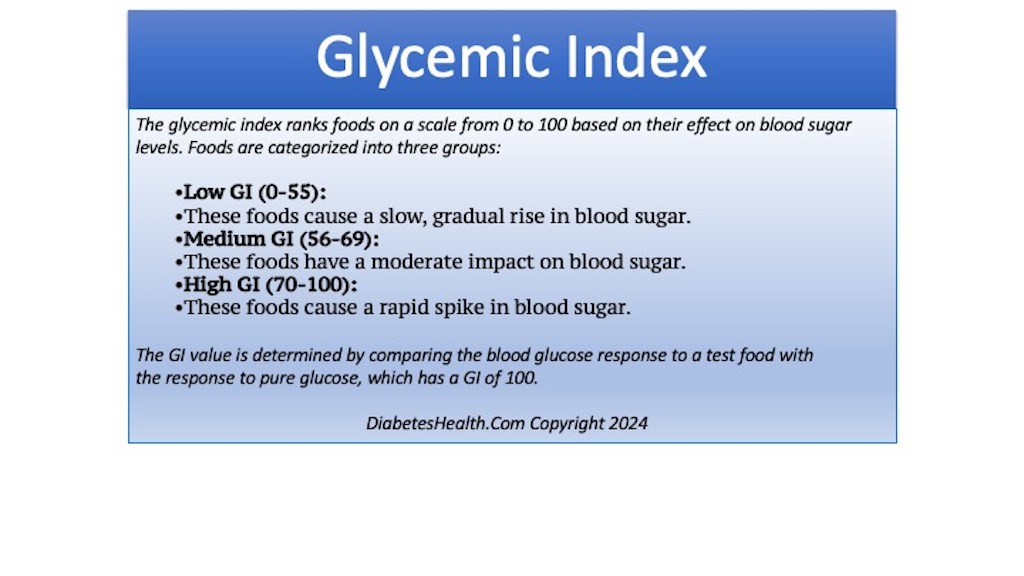
The glycemic index (GI) is a ranking system that measures how quickly carbohydrates in foods raise blood glucose levels. This index is crucial for individuals managing diabetes, weight, or general health, as it helps in choosing foods that promote stable blood sugar levels.
For low glycemic food recipes that do not compromise taste, go to The Sugar Happy Kitchen.
What is the Glycemic Index?
The glycemic index ranks foods on a scale from 0 to 100 based on their effect on blood sugar levels. Foods are categorized into three groups:
- Low GI (0-55): These foods cause a slow, gradual rise in blood sugar.
- Medium GI (56-69): These foods have a moderate impact on blood sugar.
- High GI (70-100): These foods cause a rapid spike in blood sugar.
The GI value is determined by comparing the blood glucose response to a test food with the response to pure glucose, which has a GI of 100.
Factors Affecting the Glycemic Index
Several factors influence the GI of a food:
- Type of Carbohydrate: Simple sugars tend to have higher GIs compared to complex carbohydrates.
- Fiber Content: Foods high in fiber usually have a lower GI because fiber slows digestion and glucose absorption.
- Ripeness: Riper fruits and vegetables tend to have higher GIs due to increased sugar content.
- Preparation and Cooking Methods: Cooking can break down starches, raising the GI. For instance, pasta cooked al dente has a lower GI than overcooked pasta.
- Food Combinations: The GI of a food can be affected by other foods consumed simultaneously. For example, adding fat or protein can lower the overall GI of a meal.
Impact on Blood Sugar Levels
Understanding the glycemic index is crucial for managing blood sugar levels, especially for individuals with diabetes:
- Low GI Foods: These foods cause a slower rise in blood glucose and are beneficial for maintaining steady energy levels and preventing spikes and crashes. Examples include whole grains, legumes, and most fruits and vegetables.
- High GI Foods: These foods cause a rapid increase in blood glucose, which can lead to spikes followed by a sharp decline. Frequent consumption of high GI foods can increase the risk of developing insulin resistance and type 2 diabetes. Examples include white bread, sugary cereals, and processed snacks.
Benefits of a Low GI Diet
Adopting a low GI diet offers several health benefits:
- Improved Blood Sugar Control: For individuals with diabetes, low GI foods help in better managing blood glucose levels, reducing the risk of complications.
- Weight Management: Low GI foods tend to be more filling, which can help in controlling appetite and reducing overall calorie intake.
- Reduced Risk of Chronic Diseases: A diet rich in low GI foods is associated with a lower risk of developing heart disease, type 2 diabetes, and certain cancers.
- Enhanced Physical Performance: For athletes, low GI foods provide a more sustained energy release, which can improve endurance and performance.
Practical Tips for Incorporating Low GI Foods
- Choose Whole Grains: Opt for whole grains like oats, quinoa, barley, and brown rice instead of refined grains.
- Include Plenty of Fruits and Vegetables: Most fruits and vegetables have a low GI, but be mindful of the ripeness and preparation methods.
- Combine Foods: Mix high GI foods with low GI foods to balance the overall glycemic impact of a meal.
- Watch Portion Sizes: Even low GI foods can affect blood sugar levels if consumed in large quantities.
The glycemic index is a valuable tool for understanding how different foods impact blood sugar levels. By incorporating low GI foods into your diet, you can achieve better blood sugar control, maintain steady energy levels, and reduce the risk of chronic diseases. Whether managing diabetes or simply striving for a healthier lifestyle, the glycemic index can guide you in making informed dietary choices.
- The Renal Warrior Project. Join Now
- Source: https://www.diabeteshealth.com/understanding-the-glycemic-index-and-its-impact-on-blood-sugar-levels/
